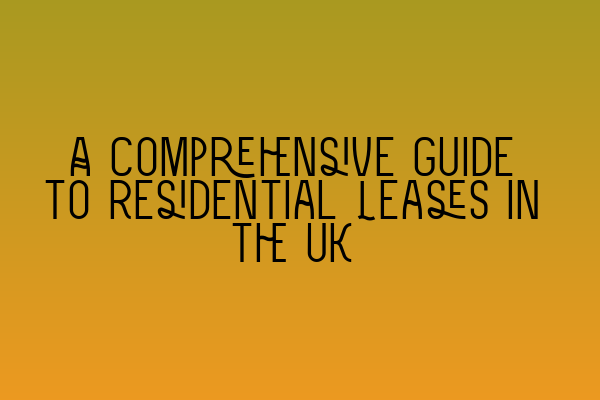A Comprehensive Guide to Residential Leases in the UK
Welcome to SQE Property Law & Land Law, where we provide expert legal services and advice on a wide range of property-related matters. In this comprehensive guide, we will walk you through the ins and outs of residential leases in the UK.
What is a Residential Lease?
A residential lease, also known as a tenancy agreement, is a legally binding contract between a landlord and a tenant. It outlines the terms and conditions under which the tenant can occupy the property for a specific period.
Related Articles:
- SQE 1 Practice Exam Questions
- SQE 1 Practice Mocks FLK1 FLK2
- SQE 2 Preparation Courses
- SQE 1 Preparation Courses
- SRA SQE Exam Dates
Types of Residential Leases
There are several types of residential leases in the UK, including:
- Assured Shorthold Tenancy (AST): This is the most common type of residential lease and offers the tenant a minimum term of six months. It provides certain rights to both landlords and tenants.
- Assured Tenancy: This type of tenancy offers the tenant more security and allows them to stay in the property for an extended period, usually for life.
- Fixed-term Lease: A fixed-term lease has a specific start and end date. The tenant has the right to occupy the property for the agreed-upon period.
- Periodic Tenancy: This type of tenancy has no fixed end date and continues until either party provides notice to terminate it.
- Break Clause Tenancy: A break clause allows either the landlord or the tenant to end the tenancy early.
Key Terms in a Residential Lease
A residential lease contains several key terms that should be carefully reviewed and understood by both parties. These terms include:
- Rent: The amount of money the tenant must pay to the landlord for occupying the property.
- Deposit: A sum of money provided by the tenant as security against any damage or unpaid rent. The landlord must protect this deposit in a government-approved scheme.
- Length of the Tenancy: The specific duration of the tenancy, whether it is a fixed term or periodic tenancy.
- Responsibilities: The responsibilities of both the landlord and the tenant, such as maintenance and repairs.
- Utilities and Services: Clarification on who is responsible for paying for utilities, such as gas, electricity, and water.
- Notice Period: The amount of notice required by either party to terminate the tenancy.
Legal Considerations
When entering into a residential lease, it is essential to consider certain legal aspects, such as:
- Tenancy Deposit Protection: Landlords must protect deposits in a government-approved scheme and provide the tenant with prescribed information.
- Gaining Possession: Landlords must follow the correct legal procedures to regain possession of the property, including providing appropriate notice and obtaining a possession order if necessary.
- Repairs and Maintenance: Both landlords and tenants have legal obligations regarding the maintenance and repair of the property. These responsibilities should be clearly outlined in the lease.
- Changes to the Lease: Any changes made to the lease during the tenancy should be agreed upon in writing by both parties and recorded as a formal amendment.
- Ending the Tenancy: The process of ending the tenancy requires proper notice and compliance with legal requirements. Failure to adhere to these procedures may result in legal issues for both parties.
Understanding the legal considerations surrounding residential leases is crucial to ensure a smooth and legally compliant tenancy for both landlords and tenants. At SQE Property Law & Land Law, we have extensive experience in advising clients on all aspects of residential lease agreements.
For more information or to consult with one of our expert solicitors, contact us today!
